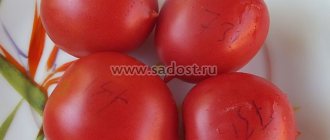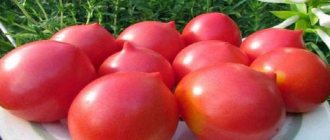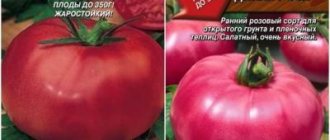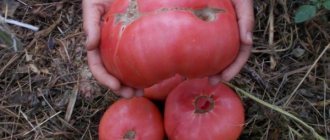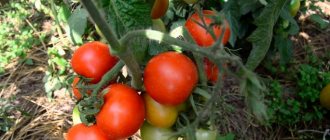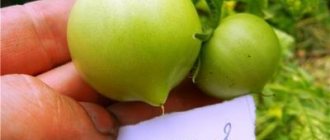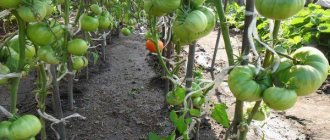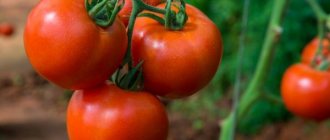Neat pink tomatoes are highly valued not only by gardeners, but also by buyers at the market. May rose is a variety with crimson-colored fruits, which are characterized by uniform ripening. Tomatoes have a wonderful taste and are used in summer salads and for preservation.
| Height | Landing location | Ripening time | Fruit color | Fruit size | Origin | Fruit shape |
| short | Greenhouse, Open ground | Early ripening | Pink | Small | Variety | Plum-shaped or oval |
a brief description of
- Where to grow: open ground in the south, film shelter in the middle zone, greenhouses in the north
- Bush height, cm: 40–60
- Ripening time, days: 80–95
- Productivity, kg per 1 m2: 8–10
- Fruit weight, g: 130–170
- Application: whole fruit canning, fresh consumption, processing
- Advantages
: universal use; - good and friendly yield of the harvest;
- immunity to many diseases;
:
- demanding watering regime;
How to grow
This tomato variety can be grown anywhere: outdoors, in a greenhouse, in an apartment on a balcony. The May Rose variety does not take up much space. This allows you to plant more bushes per square meter.
Producing seedlings should begin 55-60 days before planting in the ground.
The bush has medium-thick stems, which allows it not to be tied to a support. But despite this, it should be done. The variety is characterized by high yield, and the branches may simply not withstand a large number of ripening fruits.
See also
Characteristics and description of the Black Prince tomato variety, its yieldRead
This variety of tomatoes has high immunity to various diseases, but not absolute. To prevent infection with various diseases, it is necessary to carry out some preventive procedures even before you place the seeds in the ground.
Also, we must not forget about the bushes in the process of growth and ripening of fruits. To guarantee the health of the bush and fruits, they should be treated with various preparations at different stages of development. It should also be noted that the variety is highly resistant to late blight.
"May Rose" loves a lot of water. Important! Be sure to water your “May Rose” with exclusively warm water. Cold water can kill the plant.
The May Rose variety does not require any special fertilizers. If you are just a beginner gardener, you can ask more experienced gardeners or a store clerk for advice on which fertilizers are best. It is recommended to use fertilizers high in potassium as well as calcium. Such fertilizers will ensure good growth and protection from all kinds of diseases. But many others will also fit.
Description
The variety was bred by Russian breeders in 2004 and quickly gained recognition. "May Rose" is a determinate plant. The bush stops growing after the formation of 4–6 clusters of tomatoes. And directs all forces to the development of fruits. The peculiarity of tomatoes of this type is a very short growing season and rapid ripening of the crop.
The height of the bush is small. Only 40–60 cm. Therefore, the plant will not take up much space in the summer cottage. The trunk does not require shaping, pinching or tying to a vertical support. Which saves time and effort when caring for the “May Rose”. It is only necessary to pick in the phase of 1–2 true leaves of the seedlings.
Description of the variety
The determinate plant is compact - it grows no more than 45-60 cm in height. The review variety belongs to the early-ripening tomatoes. From planting seedlings to the ripening of the first fruits, 80-95 days pass.
The bush stops growing after the formation of 4-6 clusters with fruits.
Description of the May Rose fruit:
- Round shape;
- Pink color;
- The weight of tomatoes is 130-170 grams;
- Dry matter content – up to 5%;
- 3-4 seed chambers;
- Possibility of transportation over long distances.
HELP: Tomatoes are stored at room temperature for a long time.
Harvest
The fruits of the "May Rose" are quite large for a small plant. They have a dark pink color. Plum-shaped. The tomatoes are meaty. Covered with thin dense skin. Moderately juicy, not watery. Dry matter content is only 5%. Delicious, with a pleasant sourness.
The harvest is universal in use. Looks good in jars when pickling or canning whole. Does not crack in beds or during heat treatment. It tolerates transportation well over long distances. Keeps fresh for a long time.
Diseases and pests
Although the May Rose variety has good immunity to diseases that affect plants of the nightshade family, it can be affected by brown rot. This disease can be treated as follows:
- Remove the affected ovaries;
- Reduce watering;
- Reduce the amount of nitrogen fertilizers;
- Reduce watering;
- Tomato plantings are treated with Oxys and Hom preparations.
IMPORTANT: To prevent the appearance of brown spot, it is necessary to regulate the lighting and watering regime.
The main pests of the May Rose variety:
- Medvedka;
- Slugs;
- Aphid.
Deep and thorough weeding and loosening the soil in the beds will help get rid of mole crickets. Treating plants with soapy water will kill aphids. Slugs will disappear after spraying the plantings with water with the addition of mustard or red hot pepper.
When grown in protected soil, tomatoes may be susceptible to invasion by the greenhouse whitefly. The pest is controlled by spraying the plantings with Confidor.
Growing
"May rose" is usually grown by seedlings. Seeds begin to germinate 55-60 days before transplanting into open ground. This is usually done in mid-May or early June.
After germination, the seedlings are placed in a sunny window. Water with warm water, through a small sieve or from a spray bottle. On rainy or cloudy days, illuminate with a phytolamp. After unfolding several true leaves, a pick is made.
In a summer cottage, bushes are placed according to a pattern of no more than 6 plants per 1 m2. Severe thickening of plantings leads to a decrease in yield and the appearance of fungus. Care comes down to:
- watering;
- weeding;
- loosening;
- fertilizing with complex fertilizers.
During active growth, tomatoes respond well to nitrogen-containing fertilizers. During the formation of ovaries, they are replaced with mixtures of phosphorus, potassium, and magnesium. These elements not only stimulate fruit growth, but also strengthen the plant’s immunity.
Landing rules
Planting in the ground or greenhouse is carried out in mid-May; sowing of seedlings is carried out 55-60 days before the approximate transplant date. The timing is calculated individually for each climate.
Growing seedlings
It is recommended to sow after processing tomato seeds. To increase plant resistance to diseases and pests, seeds are soaked for 15 minutes in a weak solution of potassium permanganate, then washed in running water. You can treat with growth stimulants or succinic acid before sowing or germinate the seeds.
To germinate, seeds are soaked for a day in a small amount of clean water. After this, they are laid out in one layer at a short distance from each other on cotton fabric. Then they wrap it up and put it in a container in a cool room. As soon as the sprouts hatch, you can begin planting.
Any containers can be used to grow seedlings. First, containers and equipment must be disinfected with boiling water or a thick solution of potassium permanganate. A layer of 2-3 cm of drainage consisting of small stones, pebbles or expanded clay is placed at the bottom of the containers. Then soft, loose, light, fertile soil is filled in (a mixture of garden soil, peat, humus and sand in a 1:1:1 ratio).
The seeds are deepened into the ground by 1-1.5 cm. Covered with a thin layer of fertile soil on top and moistened with a spray bottle.
The containers are covered with a lid, glass or covered with cling film. This allows you to create a favorable microclimate for the emergence of friendly shoots.
Tomatoes of the May Rose variety need long daylight hours. Lack of sunlight negatively affects their growth.
Diving tomatoes
With the appearance of the first two cotyledon leaves, it is necessary to plant the plants. Transplanting or thinning seedlings allows you to increase the living space for the formation of a branched root system, which plays an important role in the nutrition of the plant.
2 hours before diving, tomato seedlings should be watered generously to soften the soil. Then they carefully dig up the plants and transfer them, along with a lump of earth, into prepared containers with soil. After transplanting, the seedlings are watered abundantly. Within a week they will take root, then you can water them with the addition of a mineral complex of fertilizers for seedlings.
7-10 days before transplanting into the ground or greenhouse, it is better to start hardening the seedlings.
Transplantation into open ground
It is better to start preparing the soil in the fall. First of all, the soil is disinfected; for this, the top layer 10-15 cm thick is removed. The remaining soil is watered with a solution of copper sulfate or potassium permanganate. Fertilizers and humus are added, everything is dug up.
It is advisable to place sand and rotted leaves at the bottom of the holes. Water with plenty of warm water, place the seedlings in the center and cover the roots with a thin layer of soil.
During the week, it is no longer recommended to carry out any care activities other than protection from the sun, frost and wind.
Photos
Description and characteristics of the May Rose tomato variety, reviews, photos
Early ripening (the period from germination to the beginning of ripening is 95 days), determinant, low-growing, unpretentious tomato variety for open ground and film shelters.
The bush is compact, 40-50 cm high, and does not need to be pinched. It is advisable to tie it to a support, otherwise the bush may collapse under the weight of the fruit. To obtain an earlier harvest, many gardeners still remove all the shoots up to the first flower cluster, but the yield is slightly smaller.
Basic qualities of fruits
The tomatoes are plum-shaped, at the ripe stage of a beautiful pink color, weighing 80-120 grams, fleshy, good (for early varieties) taste. Not prone to cracking. These tomatoes are universal in purpose - suitable for early fresh salads, as well as for canning and processing into tomato products.
This tomato variety is not included in the state register of breeding achievements of the Russian Federation.
Disease Prevention
"May Rose" is resistant to major nightshade diseases. To avoid problems, seedlings should not be planted in the ground where they grew last season:
- legumes;
- potato;
- tomatoes;
- pepper;
- eggplants.
Proper agricultural technology will help avoid the appearance of pests - mole crickets, aphids, slugs. Flying insects are repelled by fragrant herbs planted next to tomatoes. Spraying with Condifor helps prevent whiteflies. They are carried out before fruiting begins.
Sometimes the variety is affected by brown rot. To prevent it, you need to treat the seeds and soil before planting with a solution of potassium permanganate. Do not apply too much nitrogen fertilizer. Remove damaged stems and fruits in a timely manner. Remove fruit bearing bushes.
If the plant is already infected, it is necessary to remove all affected parts. Burn them immediately. Reduce watering slightly. Treat tomatoes with industrial preparations “Hom” or “Oxide”.
Rose of May tomatoes on video
If you grew Rose of May tomatoes, please write whether you liked them or not. What was the yield and taste of the fruits like under your climatic conditions? How do you assess the resistance of this variety to late blight and other diseases? If possible, attach to the comment a photo of the entire bush as a whole or individual fruits that you grew. Thank you!
Your reviews of the May Rose tomato and additions to the description will help many gardeners evaluate this variety more objectively and decide whether it is worth planting or not.
This is a natural variety of tomato. Therefore, we recommend taking seeds from a ripe fruit and using them for planting in subsequent seasons.
Video “Tomatoes without diseases”
Neat pink tomatoes are highly valued not only by gardeners, but also by buyers at the market. May rose is a variety with crimson-colored fruits, which are characterized by uniform ripening. Tomatoes have a wonderful taste and are used in summer salads and for preservation.
| Height | Landing location | Ripening time | Fruit color | Fruit size | Origin | Fruit shape |
| short | Greenhouse, Open ground | Early ripening | Pink | Small | Variety | Plum-shaped or oval |
Description and characteristics of the variety
The May Rose tomato is a determinate, low-growing variety. The bushes have the following features:
- height varies between 50-60 cm;
- shoots are compact and durable;
- fruiting clusters from 6 to 8;
- There are 8 to 12 tomatoes in clusters.
Ripening dates are early - 85-98 days from germination. Description of fruits:
- average weight 130 g;
- seed chambers 3-4;
- durable skin.
Country of origin and year of registration
Russian breeders participated in the creation of the variety. Entered into the State Register in 2004.
